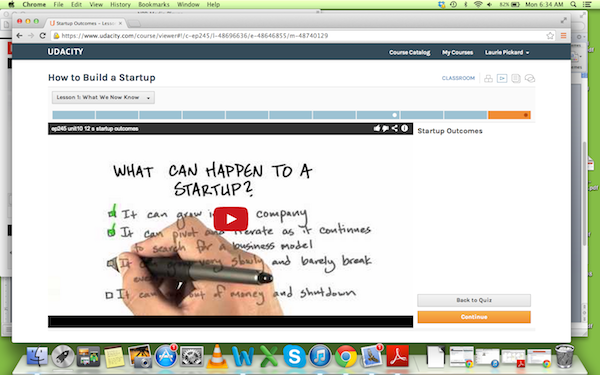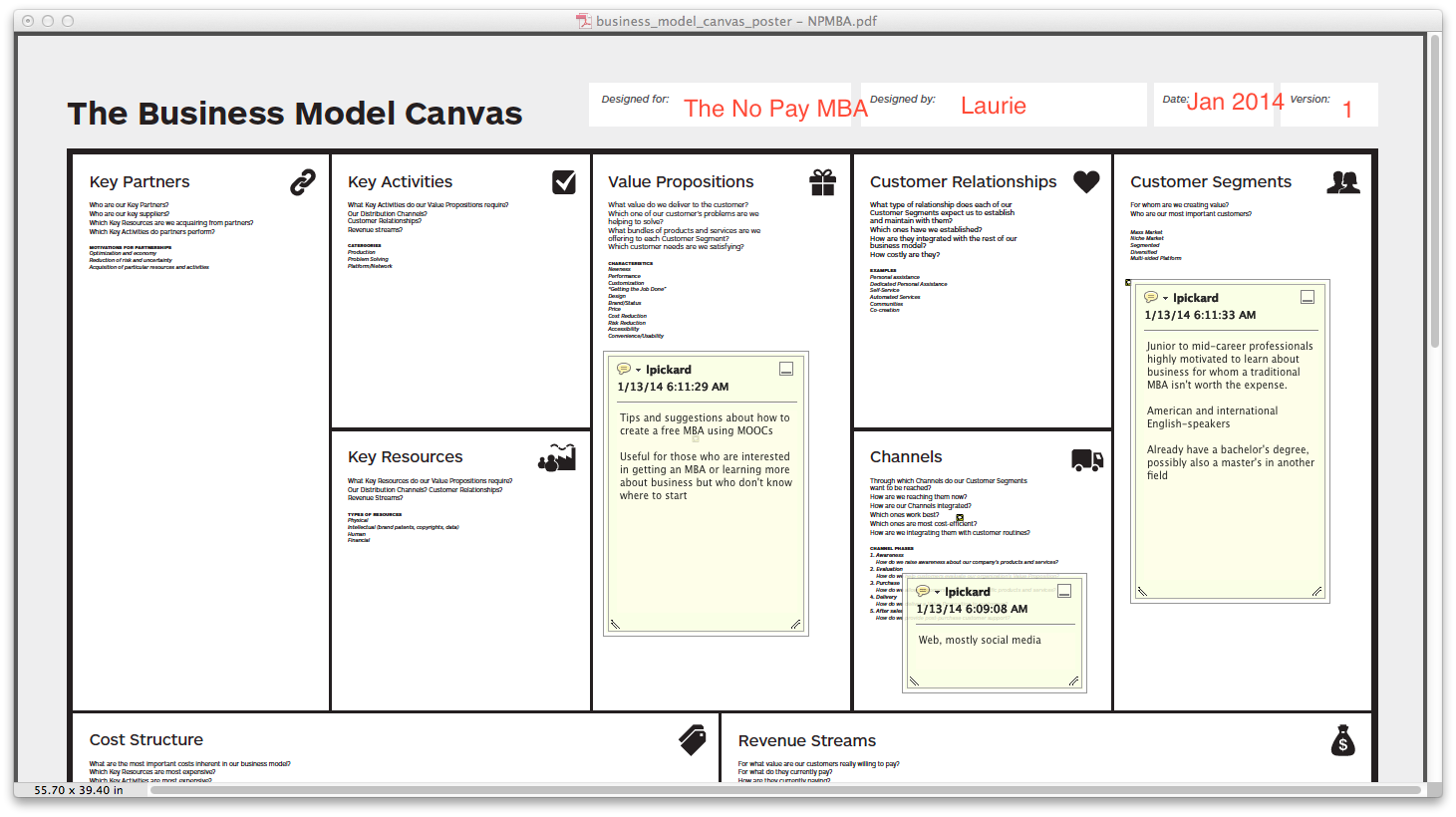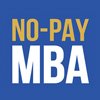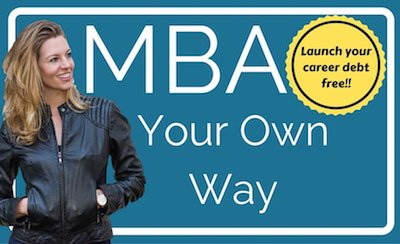by Laurie Pickard | Jan 25, 2014 | Community and Networking

In a previous post I made an offer to others working on a No-Pay MBA. I said that if you reached out to me I would profile you on my blog. I’d like to formalize my offer, as I’ve since received many comments from people who are or have started working on MBA courses via MOOC. I’m excited that so many people have been inspired to try out the whole MOOC thing. But for the purposes of this post, I’m looking for people who are going for the whole enchilada, not just a few courses. That’s right.
It’s recruitment time for the No-Pay MBA.
 I am looking for a few strong candidates to showcase on my blog.
I am looking for a few strong candidates to showcase on my blog.
In order to be eligible you must be committed to taking a full series of MBA courses via MOOC.
Ideally, you will have already taken several business courses and will be registered for or have plans to take more.
You will be willing to make a public commitment to reaching your goal. We all know that MOOC completion rates are abysmal. Making public your intention to finish not just one, but many courses can be extremely valuable in maintaining motivation. Going public is also a way to start building a network of people who recognize the value of your self-administered education.
If you are interested in being featured on this blog, please write to me at laurie@nopaymba.com. In your message, include the following:
-
- Your name, age, city and country of origin, and where you are currently living
- Your current job or field
- Why you decided to do a MOOC MBA
- Your career goals after finishing your MBA coursework
- Courses you are currently taking or have taken
- Any other thoughts you would like to share with readers
- A small picture of yourself
Finally, I would like to mention that this is a standing offer. You may be thinking about doing a No-Pay MBA but not yet have started. In that case, bookmark this page and come back to it when you are ready to officially begin.
by Laurie Pickard | Jan 21, 2014 | Thoughts on Higher Ed and Life
 Since an article about the No-Pay MBA went viral on LinkedIn, I have received an overwhelming response to my project. The LinkedIn article was viewed over 350,000 times (and counting) and shared over ten thousand times. Over 700 comments were posted on it.
Since an article about the No-Pay MBA went viral on LinkedIn, I have received an overwhelming response to my project. The LinkedIn article was viewed over 350,000 times (and counting) and shared over ten thousand times. Over 700 comments were posted on it.
I want to say thank you to all those who have reached out to me. In the past week, I have received hundreds of contact requests on LinkedIn, dozens of comments on my blog, a slew of shout-outs on Twitter, and many new subscribers to the No-Pay MBA newsletter. While many of the comments on the LinkedIn article were skeptical, everyone who reached out to me directly was enthusiastic about the potential of this method of learning. Your support has been overwhelming and inspiring.
Unfortunately, in order to respond individually to everyone who contacted me, I would probably have to quit my job, so please don’t be offended if I don’t reply to you with a personal message. I’ve tried to be transparent about what I’m doing, so most of the questions I’ve been asked in personal messages are answered on the blog (e.g. What courses are you taking? How did you decide which courses to take? Are you getting credit towards a regular degree? Don’t you think you’re missing out on the MBA network?)
If you’ve read through the blog and still have questions, I encourage you to post them publicly as comments on the blog so that I can respond in a way that benefits other readers who might have similar questions. And please keep the feedback and suggestions coming! I also encourage you to chime in on any of the online discussions that are taking place around this concept. Even though not everyone is convinced that the No-Pay MBA is the wave of the future, I’m thrilled to have sparked such a lively discussion.
Finally, I’d like to share a few of my favorite comments and exchanges inspired by the article:
On the LinkedIn post:
“Depending on where she applies for her next job, I’m sure some employers will be impressed by her resourcefulness if she actually completes it - this is the stuff cover letters are made of. If her actual skills/knowledge is put in question, employers can do what they do with every other employee and administer some kind of test or pepper the interview with intentional questions about her knowledge.”
“True, she won’t be receiving any accredited degree but she will be showing that she completed the same course load as an accredited MBA which to me shows some ingenuity in the method of receiving the education. Isn’t this an example of what true forward thinking corporations want in an employee that thinks outside the box? Sure, not every firm is going to see this as an MBA equivalent or even a smart approach, but those are probably the firms that sort candidates based on where the candidate went to school without even evaluating the candidate’s potential, etc. This is also not the same as just reading some books. These are college level courses taught by tenured professors with testing in some cases. The only issue for a potential employer is of course verifying the validity of a MOOC MBA but I imagine at least for the foreseeable future there will not be a tremendous amount of them so to take a chance on a person won’t be a big deal. Plus, MBA level people already have an extensive work history at this point in their careers.”
On a related Poets and Quants article:
“Commenter1: This is awesome! Just curious, how would you list this on a resume? What ethical guidelines are there for listing yourself as an MBA from a MOOC?
“Commenter 2: Here’s how I see it: You would include a one-page overview of your MBA studies, listings the courses you’ve taken, the schools that sponsored them, the dates you completed them, and the grades you’ve received. You would divide the courses up by “core courses” and “elective courses.” And you would say you did what no mainstream MBA has ever done: Taken a full load of MBA courses on your own which demonstrated self-discipline, a thirst for learning, and the hard work to see it all through–and you are smart enough to get your MBA for free, saving yourself more than a quarter of a million dollars in tuition, school fees, and opportunity costs. What’s more, you will have gotten it by studying with professors from the world’s best business schools: Wharton, Yale, Stanford, Virginia, Northwestern, etc. You will even be able to say you took a course from a recent Nobel Prize winner, Robert Shiller of Yale, whose course on financial markets is coming out this February.
“Now this isn’t going to work at a McKinsey or Bain, but I think it would impress most employers greatly and make a difference in your employment prospects. And if you are able to pull this off you will have learned everything an MBA at Harvard or Chicago will have learned. You won’t have the network or the ideal sequence of learning that is part of a highly organized, lockstep MBA program. But it’s free!”
On my most recent blog post:
“Folks can debate till the end of time on how effective MOOCs can be w/o a stamp or piece of paper, but in the end, it’s the ones devoted to learning and building something useful out of it that will create the learning structure they need and come out with a story to tell on a resume or interview, and no one says networking is limited to B-school.
“Besides, by the time traditionalist MBA kids are done forking over $100k and polishing their resumes for jobs, you’ll be ready to apply what you’ve learned and start hiring them.
“Thanks for choosing to be so open to share your experiences; I’m on a similar path (science oriented), but am happily learning more now than I have in years. Onwards!”
by Laurie Pickard | Jan 17, 2014 | Thoughts on Higher Ed and Life
 It’s been an exciting few days, with an article about the No-Pay MBA appearing on Poets and Quants, CNN Money/Fortune, and a host of other websites. I couldn’t be happier about the press coverage. The overall response to my project – in comments on my website and on the articles, and through Facebook and social media shares – has been incredibly positive. I’ve even heard from a few people who have been inspired to start their own MOOC-based educational programs.
It’s been an exciting few days, with an article about the No-Pay MBA appearing on Poets and Quants, CNN Money/Fortune, and a host of other websites. I couldn’t be happier about the press coverage. The overall response to my project – in comments on my website and on the articles, and through Facebook and social media shares – has been incredibly positive. I’ve even heard from a few people who have been inspired to start their own MOOC-based educational programs.
I have also, however, received a few skeptical comments. Several people have asked whether a university will be granting me a degree at the end of all this. (Answer: No.) One even wondered what would be the point of doing all this work if I wasn’t expecting to get a degree out of it.
I’m happy to accept criticism of my project – in fact, it is only by addressing its weaknesses that I can improve it. So thank you to those who have raised these questions. While thinking about the issues readers have raised, I have also been considering the material I am learning in my course on how to build a startup. One of the core components of building a startup is defining its value proposition. It is critical to understand exactly what problem your product is trying to solve, and for whom. Although I don’t have any current plans to turn the No-Pay MBA into a business, I do care about providing a valuable product to my “customers,” i.e. my readers.
I assume that, like me, my customers would like to have an MBA, but aren’t convinced that traditional degree programs are worth the time and money they cost. I created the No-Pay MBA as a solution to that problem – but as my critics have recognized, so far it is only a partial solution. The value of any degree can be broken down into three parts: what you learn, signaling, and connections. Let’s consider how the No-Pay MBA might address each of these.
Skills and knowledge are the foundation
One of my biggest questions before starting this project was whether enough information was out there, freely available, to add up to an MBA, and whether I could absorb that material through the MOOC format. The more MOOCs I complete and the more courses that come online, the more I believe that there is plenty material out there, and that I can in fact absorb it. I won’t have a problem learning as much as or more than I did in my brick-and-mortar graduate program. Especially interesting for me in reading the responses to the Poets and Quants article is that almost no one has questioned my ability to learn B-school material through MOOCs.
Again, I am reminded of my course on startups. The instructor says over and over that the only way to test your hypotheses is to “get out of the building” and speak to your potential customers. When I first started this project, I thought that the primary value of my blog would be to provide readers with a roadmap for combining courses into an MBA so that they too could acquire business skills free of charge. I still do see the roadmap function as being an important part of the blog, but I can see that there are other “pains” (to use the language of the startups course) associated with getting a MOOC-based MBA that I could address.
A school is a brand
While new skills and information are the backbone of an education, they do not comprise its entire value – otherwise there’s no way top B-schools would be able to command upwards of $100,000 for a two-year degree when much of what they teach is available free of charge. Much of the value, and for some people the lion’s share of it, comes from the other two components – the signaling and the network.
What do I mean by signaling? When an employer sees on your resume that you got an MBA from Harvard Business School, he or she assumes you are top-notch. If you got into Harvard, you must be smart, and if you finished, you must have learned something. That is the signal that the Harvard name sends. In other words, a degree-granting institution functions like a brand.
A MOOC can’t provide the first part of the signal, since there isn’t any admissions process. It is, however, possible that some of the prestige of the universities offering MOOCs will rub off on the students who complete them – I certainly hope that is the case. But it remains to be seen whether employers will read completion of a series of MOOCs from prestigious schools as a signal of actual learning.
As I’ve said, I know I’m learning. So how can I bring credibility to the No-Pay MBA? Appearing on CNN Money certainly helps my individual case, but will it help anyone besides me? I do think that a highly publicized example can help other people by raising awareness about the possibilities MOOCs present.
I wonder whether MOOC students would find value in third-party verification – not a stack of Statements of Accomplishment, but a certificate from another provider that attests to your completion of a course of study. For a model of this approach, check out Skills Academy.
The value of a network
Most of the comments I received questioning the value of the No Pay MBA centered on signaling, but I also see a great opportunity for networking among “graduates” of self-designed degree programs. If we can organize ourselves, we could help each other out by sharing information, offering advice, and making real-world connections. I would love to see the No Pay MBA site become a hub for people pursuing MOOC-based MBAs.
If you are attempting a MOOC MBA and can think of other ways this website can help you out, I would love to hear from you.
by Laurie Pickard | Jan 13, 2014 | Courses, Platforms, and Profs

As I’ve mentioned previously, this semester I’m focusing on finance and entrepreneurship. To kick off the entrepreneurship piece, I’m taking a course from Udacity called How to Build a Startup. It is a fantastic course. First of all, Udacity is different from other platforms both in terms of the format and the concept behind it. All of Udacity’s courses are self-paced. In my course, each unit is made up of a series of very short videos – around 2 to 3 minutes. I don’t have much time to do coursework during the work week, but sometimes with this course I tell myself I’ll just watch a couple of videos and then end up finishing a unit because the videos are so quick and engaging.
The other thing I love about Udacity is that all of the courses are focused on acquiring practical skills. Courses are exclusively in the fields of science, technology, math, and business – many are in computer programming. How to Build a Startup avoids all of my pet peeves about MOOCs - the instructor never asksus to post on discussion forums just for the sake of posting, he urges us constantly to get out of the building and test our hypotheses on potential customers, and he goes into detail rather than just skimming the surface of the topics he’s covering.
The backbone of How to Build a Startup is something called the Business Model Canvas. This is a great tool for organizing your thinking around a startup business. The instructor, Steve Blank, who has founded many startups, emphasizes that filling in the spaces on the canvas is an iterative process that must involve talking to potential customers. I’m only three units into the course, but I’ve already started thinking about several business ideas. The most tangible so far relates to my current project, The No Pay MBA. Since starting this course, I’ve been thinking in a new way about the value proposition my blog offers to my readers (a.k.a. my customers). I’d love to see this blog become a sort a community hub for people who are working on their own free MOOC-based MBAs.
Below is a partially filled in first iteration of my business model canvas. You can click on it to see a larger version. I’d love to hear from you about what needs those of you who are contemplating doing a No Pay MBA would like to have addressed, what uncertainties or challenges or annoyances you’ve experienced so far if you’ve already started one.

by Laurie Pickard | Jan 3, 2014 | Thoughts on Higher Ed and Life
 One of the best things about a No-Pay MBA is that you can start one any time. Because new MOOCs are starting pretty much continuously, it isn’t necessary to stick to a semester schedule. Still, it can be helpful to break up the year into chunks, and many new classes are released around when college semesters typically start. So, as we head into spring semester, here are a few tips to help as you choose your courses.
One of the best things about a No-Pay MBA is that you can start one any time. Because new MOOCs are starting pretty much continuously, it isn’t necessary to stick to a semester schedule. Still, it can be helpful to break up the year into chunks, and many new classes are released around when college semesters typically start. So, as we head into spring semester, here are a few tips to help as you choose your courses.
1. Go in with an idea of the topics you’d like to study, but be flexible.
I think it’s a good idea to have an overarching structure to guide you, rather than just taking business courses willy nilly. That said, because it’s hard to predict which courses will be available when, it’s important to remain flexible. For example, I had planned to take a marketing course this semester, but I haven’t found any yet. So instead I’ve chosen to take some advanced courses in finance and entrepreneurship, which I was planning to do the following semester.
2. Choose courses from a variety of sites.
When it comes to business and management courses, Coursera has the best selection by far. But don’t forget about NovoEd, Open2Study, Udacity, and Canvas, all of which have a good selection of business courses as well. Not all of my courses are taught by university professors either. I am working on a Udacity course on entrepreneurship with a teacher who is a phenomenal lecturer with loads of real-world business experience. For my purposes, it doesn’t matter that he isn’t connected with a university.
3. Set up a mail filter.
I highly recommend sending all of your MOOC-related mail to a dedicated folder. If you use Gmail – and who doesn’t these days? – and don’t know how to set up a filter, you can learn how to do it here. As soon as I register for a new MOOC site, I immediately set up a filter to send all mail from that site’s domain name to go to my “MBA” folder. That way, there’s only one place in my inbox to look for all course updates.
4. Do a trial or “shopping” period, then un-register from courses you don’t want to take.
When I was in college, at the beginning of every semester I would register for a dozen classes, attend each of them a couple of times, and then make a final decision about which of them to attend for the entire semester. I recommend a similar strategy for your No-Pay MBA coursework. So far, I am registered for a course in human resources, one on financial markets, one on entrepreneurship, one on financial analysis of entrepreneurial ideas, and one from the HEC School of Management in Paris (in French, I might add) on valuation. If my schedule looks a bit finance-heavy, well it is. I don’t plan to finish all of these courses – I just want to test them out. If you “shop” a bunch of couses before you commit, I think it’s polite to un-register once you’ve decided which ones you’re not interested in finishing. It also cuts down on email clutter.
5. Leave a little room in your schedule for surprises.
Last semester my schedule was so packed I didn’t have time to add any new courses mid-way through. But what if Harvard Business School finally releases it’s long-awaited MOOC series? I want to have some time in my schedule to take a really good course that pops up.

 I am looking for a few strong candidates to showcase on my blog.
I am looking for a few strong candidates to showcase on my blog.





 One of the best things about a No-Pay MBA is that you can start one any time. Because new MOOCs are starting pretty much continuously, it isn’t necessary to stick to a semester schedule. Still, it can be helpful to break up the year into chunks, and many new classes are released around when college semesters typically start. So, as we head into spring semester, here are a few tips to help as you choose your courses.
One of the best things about a No-Pay MBA is that you can start one any time. Because new MOOCs are starting pretty much continuously, it isn’t necessary to stick to a semester schedule. Still, it can be helpful to break up the year into chunks, and many new classes are released around when college semesters typically start. So, as we head into spring semester, here are a few tips to help as you choose your courses.
